Fuso class battleships (1915)
 Japan, 1915. Fuso, Yamashiro.
Japan, 1915. Fuso, Yamashiro.
The first Japanese-designed super-dreadnought: These powerful dreadnoughts were far-off derivatives of the HMS Dreadnought in 1906. Their plans had been designed in Japan for the first time, and thus didn’t have many changes made to their design based on combat experience as the nation had not participated in any major dreadnought-era battles to that point. Yet, their designers still attempted to push the limits with the new ships. Their speed was stepped up to the next level, reaching near that of a battlecruiser, while still having the classic protection of a dreadnought. In the end, they succeeded in creating the first Asian fast battleship, in line with the new breed designed in UK and Germany (The Queen Elisabeth and Baden classes).

IJN Yamashiro in 1917, testing anti-torpedo nets at Yokosuka NyD (Colorized by Hirootoko JR)
To house her huge machinery able to deliver more than 26 knots, the hull was massive. The Fuso and Yamashiro were laid down in 1912, launched in 1914-1915 in Kure and Yokosuka, and commissioned in 1917. They were by then among the most powerful warships in the world, and in many ways, the very embodiment of imperial ambitions in Asia.
Disputable choices in armament
In terms of armament, there was an emphasis on the power of their broadside. With some external post insight, their final complement of 12 14-inch guns with 4 firing fore and aft was not satisfactory compared to the US solution of having six guns massed in the chase or retreat with triple turrets (like on the Pennsylvania and New Mexico classes) or compared to the British solution of mounting larger caliber guns. The following Ise and Nagato would follow the same path of twin turrets, probably because the Fuso’s (and in general Japanese 14/16 in battleship turrets) were closely derivated from British models, and second because it was a reflection of the traditional line of battle tactics like crossing the T. An evolution of this idea would come to light after Jutland and gradually massed artillery at the front was seen as more desirable in the 1920s (as seen on Nelson and Dunkerque).

IJN Fuso in drydock at Kure, 1933 – reddit. Colorized by Hirootoko JR
IJN policies and the 8-8 plan
The Fuso class ships were the result of the shift in focus from the Russians, who were soundly defeated in 1905 and no longer a potential competitor, to the presence of the United Kingdom and US Navy with advanced and well-fortified outposts such as Manila or Singapore. Though the Fuso class was meant to fight first in Japanese territorial waters, strategist Satō Tetsutarō warned this next confrontational step was inevitable and Japan needed to maintain at all times a battleship fleet at 70% of the US Navy’s strength. Thus, the 1907 program of sixteen battleships (8-8 plan) began. After the first Japanese dreadnought, the IJN Kawachi in 1910, the diet curtailed the budget for the original plan and after many debates eventually authorized four battlecruisers of the Kongo class and a single Fuso class BB.

IJN Fuso circa 1916, colorized by Hirootoko JR.
Design of the Fuso class
Fusō’s design was essentially the product of studying both the four battlecruisers in construction and close coordination with the British during construction. British design studies in naval architecture were just borrowed and adapted for a domestic battleship design aimed at combating the New York class. Specs included twelve 14-inch (36 cm) guns and better speed than 21 knots (39 km/h; 24 mph). Looking back on the introduction’s emphasis on turret arrangement, the Japanese had access to the designs for triple-gun turrets but nevertheless opted for six double turrets perhaps for the points mentioned above.
The final design tentatively named A-64 called for 29,000 long tons ships with the armament noted, and a top speed of 23 knots (43 km/h; 26 mph) was by then superior to her American equivalents both in armament and speed, in line with the orientation on qualitative superiority which would also fuel the design of the Nagato and Yamato afterward.
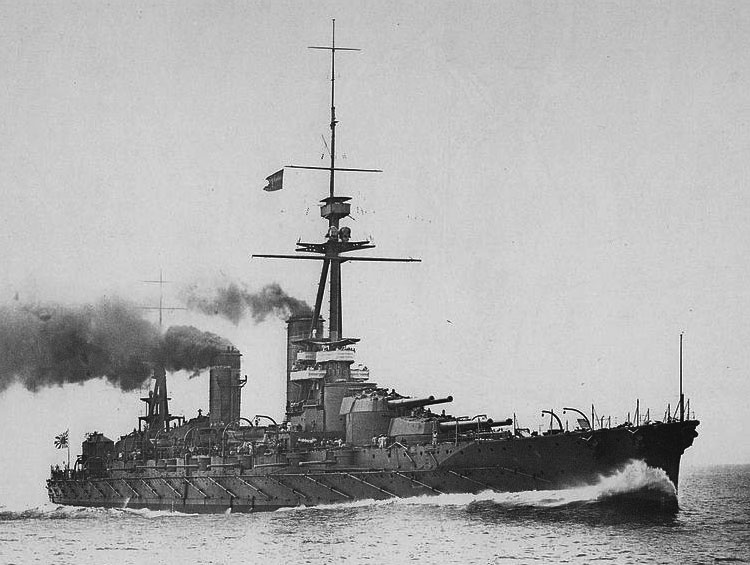
Fuso on trials, 1915.
General features: The Fuso and Yamashiro as built
These ships were 202.7 meters (665 ft 0 in) in length overall, and thus well beyond the regular observed size of most battleships. This made for an elongated hull, giving them more speed, at the cost of their agility. The beam was 28.7 meters (94 ft 2 in), in the standards of the time, for a still-comfortable draft of 8.7 meters (28 ft 7 in). Their displacement was 29,326 metric tons (28,863 long tons) as designed, and their crew comprised 1,198 officers and enlisted men in 1915. With the addition of more modern armament, fire control, security teams, and AA artillery, this rose to 1,396 in 1935 after a refit and around 1,800–1,900 men during the war. The ships even could carry 3,000 men or more on their decks as shown during operations where they served as improvised troop transports.
Powerplant
The Fusō and Yamashiro shared the same twin sets of Brown-Curtis direct-drive steam turbines mated on their propeller shafts. To make travel more efficient, medium-pressure turbines drove the wing shafts and high-/low-pressure turbines drove the inner shafts. Turbines produced 40,000 shaft horsepower (30,000 kW) in total. Steam came from 24 Miyahara-type water-tube boilers firing coal and oil. The ships carried 4,000 long tons (4,100 t) of coal and 1,000 of fuel oil. Their range was therefore 8,000 nautical miles (15,000 km; 9,200 mi) at 14 knots (26 km/h; 16 mph), enough to reach the southern pacific from Japan. Their designed speed was 22.5 knots (41.7 km/h; 25.9 mph) but in sea trials, Fusō reached 23 knots (43 km/h; 26 mph) and Yamashiro 23.3 knots (43.2 km/h; 26.8 mph) with forced heat and 47,730 shp.
Protections
Both battleships’ armor was typical for pre-Jutland battleships and represented a total of 8,588 long tons (8,726 t) or 29% of their total displacement. The waterline armor belt was 229-305 mm (12 to 9 in) with a strake of 102 mm (4 in) below. Decks ranged from 32 to 51 mm (1.3 to 2.0 in). Their turret faces were 279.4 mm (11.0 in) and 228.6 mm (9.0 in) on the sides. The roofs were 114.5 mm (4.51 in) and their barbettes were 305 mm thick. The 6-in casemates were protected by similar thickness (152 mm) armor plates. The conning tower was 351 mm (13.8 in). No less than 737 watertight compartments were arranged underneath or above the armor deck to preserve buoyancy.
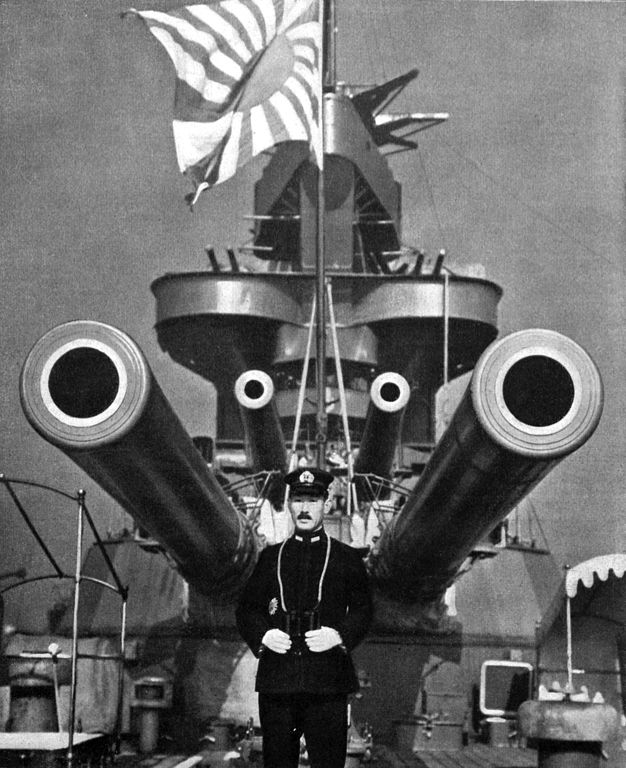
Yamashiro’s 14-in guns and Vice-Admiral Sankichi Takahashi
Armament
The main battery comprised as said above of six twin turrets arranged on the centerline, two in central elevated mounts and two on superfiring positions for and aft. These 45-caliber 14-inch guns could elevate up to −5/+20 degrees. The decision of using twin turrets was rather poor as stated above, but in addition, it affected the length of protection required and led to 4 of the guns being forced to shoot from limited angles. These design flaws would be solved in the next class of battleship, the Ise, but would have to be endured by the Fusos. More space indeed was used by that central arrangement than a pair of superfiring turrets in the center, not to mention the restricted arcs of fire, and boiler rooms placed in odd locations, plus the extra requirements for additional insulation and air conditioning in the magazines because of their proximity to the boilers. The battery was modernized during the interwar, but never fully moved.
The original secondary armament comprised sixteen 6-in/50 guns in single casemates on each side on the upper deck level. Their arc of fire was 130 degrees with a +15° elevation. Their shell was the 45.36-kilogram (100.0 lb) HE model capable of a 22,970 yard (21,000 m) range. The guns’ RPM was about six shots with a well-trained crew. The decks and bridges also saw the installation of 5-6 76 mm/40 AA guns (3 in). They had a 75° elevation on each side of the forward superstructure, second funnel, and aft superstructure, and fired a 6 kg (13 lb) projectile at 680 m/s (2,200 ft/s) and 7,500 meters (24,600 ft). Finally, the ships had six 533 mm/21 in torpedo tubes submerged on the broadside for close-quarter combat.
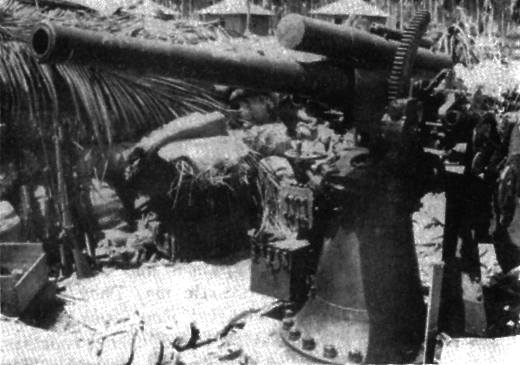
IJN ww1 76 mm (3-in) AA gun
Interwar overhauls and refits
Serious things began to start in effect around 1925. By that date, the super-dreadnoughts that were to replace the Fuso class had been canceled by the Washington Treaty and were being converted into aircraft carriers. The rebuilding and overhaul of the Fuso began in 1930 and ended in 1933, then continued in 1935 and ended in 1937, while its twin Yamashiro, made it in one go, from 1930 to 1935. These years served to rebuild their machinery and boilers, resulting in a new silhouette, rebuilding their gangway and rear blockhouse, laying a catapult and service rail for the three embedded seaplanes, new rangefinders, control rooms, reconnaissance means and optical at the tip, as well as a more powerful AA. The hull was enlarged and lengthened and underwater protection greatly improved, with the ship’s speed upgraded to 25 knots.
1933 Refit
Modernization of 1933-35 consisted of having both ships’ superstructures enlarged and new platforms stacked up all along their high tripod foremasts with the last one on top being the main fire direction bridge. All the intermediary ones contained command bridges, control rooms, light projectors, stereoscopic rangefinders and telescopes, morse projectors or signal systems, light AA guns, and many other modules.
The rear superstructure was also rebuilt. The primary goal was to accommodate 127 mm (5.0 in) AA gun mounts and additional fire-control directors. Crucially, ASW was a concern and generous torpedo bulges were added to the hull to improve their underwater protection and stability, balancing out the added belt armour. To not lose too much in terms of speed due to the increased beam of 33.1 m (108 ft 7 in), the sterns were lengthened by 7.62 meters (25.0 ft) for a final overall length of 212.75 m (698.0 ft). All this weight produced a draft of 9.69 meters (31 ft 9 in), with their overall displacements jumping to 4,000 long tons (4,100 t), and final displacements to 39,154 long tons (39,782 t) fully loaded in battle order.

Fuso at Yokohama in 1928
Propulsion modernization
On the power side, the Miyahara boilers were replaced by six new Kanpon oil-fired boilers. Therefore the exhausts were truncated and the forward funnel removed while four geared Kanpon turbines were fitted. This brand new powerplant produced a total of 75,000 shp (56,000 kW) as designed, and on trials, this produced a top speed of 24.7 knots (45.7 km/h; 28.4 mph) for about 76,889 shp while fuel storage reached 5,100 long tons (5,200 t) of fuel oil, enough for 11,800 nautical miles (21,900 km; 13,600 mi) at 16 knots (30 km/h; 18 mph). While not performances of a true interwar super-dreadnought, they were sufficient for the task of ships of that era.
Protection modernization
During reconstruction, the armor was upgraded, with deck armor increased to 114 mm (4.5 in), and longitudinal bulkhead 76 mm (3.0 in) (with high-tensile steel) for better underwater protection. Their total armor tonnage was brought to 12,199 long tons (12,395 t), 31% of the total displacement, but this was still not enough to withstand 14-inch shells.
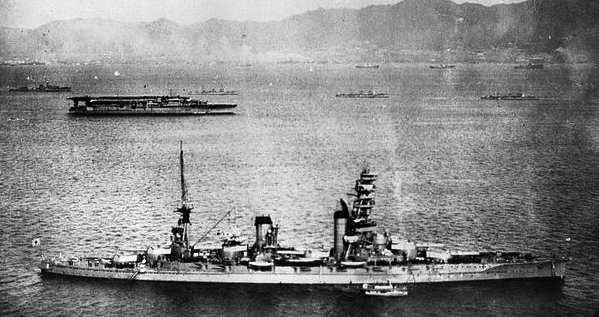
Yamashiro and Kaga at Kobe in 1930
Armament modernization
The main battery of the Fusō at first had an elevation of −5/+43 degrees, for a maximum range of 35,450 yards (32,420 m). The recoil mechanism of the guns was also modified to a more modern and faster pneumatic system. During the war, Type 91 armor-piercing capped shells of 673.5 kg (1,485 lb) were used. Muzzle velocity was 775 mps (2,540 ft/s) for an effective range of 27,800, up to 35,450 meters (38,770 yd) at +43°. The second shell fitted for these guns was the 625 kg (1,378 lb) HE model which had a muzzle velocity of 805 mps (2,640 ft/s). Finally, a small provision of Type 3 Sankaidan incendiary shrapnels for AA use was also carried after the 1930s refit.
For the secondary battery, the elevation of the 6-in guns was increased to +30 degrees, adding an extra 900ms (980 yds) of range while the light battery was modified. All of the 76 mm guns were replaced with eight 127 mm/40 (5.0 in) DP (dual-purpose) guns fitted on both sides of the fore and aft superstructures in twin mounts. Their practical range was 14,700m (16,100 yd) and their ceiling 9,440m (30,970 ft) at a +90° of elevation. They had a rof of 14 rpm, down to 8 in sustained fire. The two foremost 152 mm guns were removed in the last modernization to save weight for more AA.
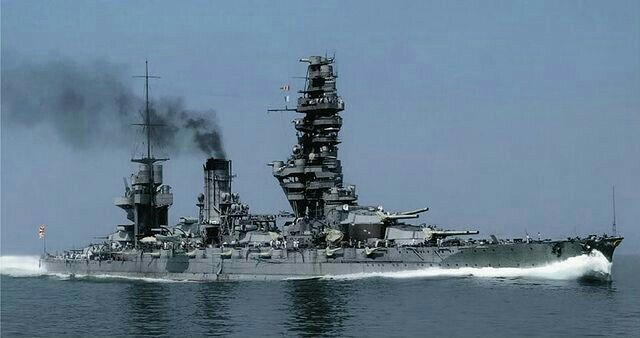
Indeed, the light AA artillery at first was reinforced by four quad 13.2 mm (0.52 in) MGs derived from the Hotchkiss model on the Fuso while Yamashiro used eight twin 25 mm (0.98 in) AA guns also under a licensed air-cooled Hotchkiss design. These existed in single, double, and triple mounts and were used as standard but suffered from many shortcomings. Insufficient speed in elevation and traverse, gun sights not able to follow fast targets, excessive vibration, small magazines, and excessive muzzle blast were criticized. The configuration of AA batteries originally diverged on both ships but after the final reconstruction, eight twin mounts became standard, and later seventeen single and two twin mounts were eventually added for 37 guns in total. By the summer of 1944, twenty-three single, six twin, and eight triple-mounts were installed for a total of 95 AA guns on each ship.
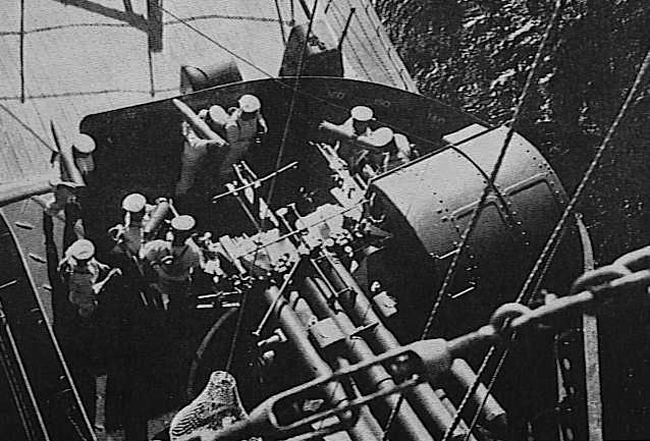
IJN standard 127 mm dual purpose twin mount gun
Another aspect of this modernization of course concerned rangefinders and fire control systems, like the analog computer table. Originally both ships were fitted with two 3.5 m (11 ft 6 in) and two 1.5 m (4 ft 11 in) rangefinders on the forward superstructure plus a 4.5 m rangefinder on Turret No. 2 roof while others were placed on turrets 3, 4, and 5. In late 1917 a new fire-control director was placed in the on the foremast top platform. The turret rangefinders were replaced by 8-meter (26 ft 3 in) models in 1923.
After refit, four directors for the 127 mm AA mounts were added each side of the fore and aft superstructures plus a rangefinder on top of the pagoda mast, replaced in 1938 by a new 10 m (32 ft 10 in) rangefinder while new directors were added on the superstructure for the 25 mm AA guns while additional ones were fitted on funnel’s platforms.
During the summer 1943 refit, a Type 21 air search radar was installed for the first time, on the roof of the main top rangefinder and the next summer in August 1944, two Type 22 surface search radar units were added plus two Type 13 early warning radars. Fusō would remain the only Japanese battleship to mount a radar on her funnel.
The Fuso class at war
In 1939, despite their recent modernization, the two ships were ancestors. However, they were still included as a major asset in the battle line of the IJN. Their peers consisted of the three pairs of Fuso, Ise, and Nagato, as well as the four Kongos. The Yamato and her twin were then in construction under the greatest secrecy. Between 1937 and December 1941, the crews of these two ships had plenty of time to train, but the active life of their ships was not as intense as expected, especially because of their age.
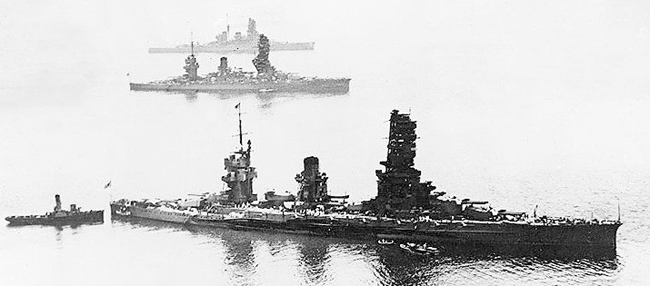
Fuso, Yamashiro and Haruna before the war.
The Fusō in action
The Fusō (a classical name of Japan) was laid down at the Kure Naval Arsenal in 1912 and was commissioned on the 8th of November 1915, naturally posted with the 1s fleet, 1st division, and patrolled off the coast of China during the Great War, and later acting as flagship. She never fired in anger during wartime. Placed in reserve in 1918 she received additional AA guns. In 1923, from 9 – 22 September her crew helped survivors of the Great Kantō earthquake. She then resumed patrols off the coast of China before going in for another refit at Yokosuka and Kure. She emerged from this in March 1935 but served as a training ship until 1937. Her second modernization started on the 26th of February 1937 and was completed on 10 April 1941. When the war broke out she was affected by the 2nd division, 1st fleet under Captain Mitsuo Kinoshita, together with the Nagato, Mutsu, and aircraft carrier Hōshō.
After patrols on the Hashirajima to the Bonin Islands she acted as distant cover for the air force that attacked Pearl Harbor in December. Her barrels were replaced at Kure on 21 February 1942, and she later tried to intercept the Doolittle force in April 1942. She participated as a screening force in strength, at the Battle of Midway, and was present at Truk and Biak in 1943 and 1944. Before that, it was thought to convert her as a hybrid aircraft carrier-battleship, but the Ise class was chosen instead, to compensate for the losses at Midway. On 18 – 24 July 1943 in drydock at Kure, she was fitted with a radar and additional 25 mm AA guns.
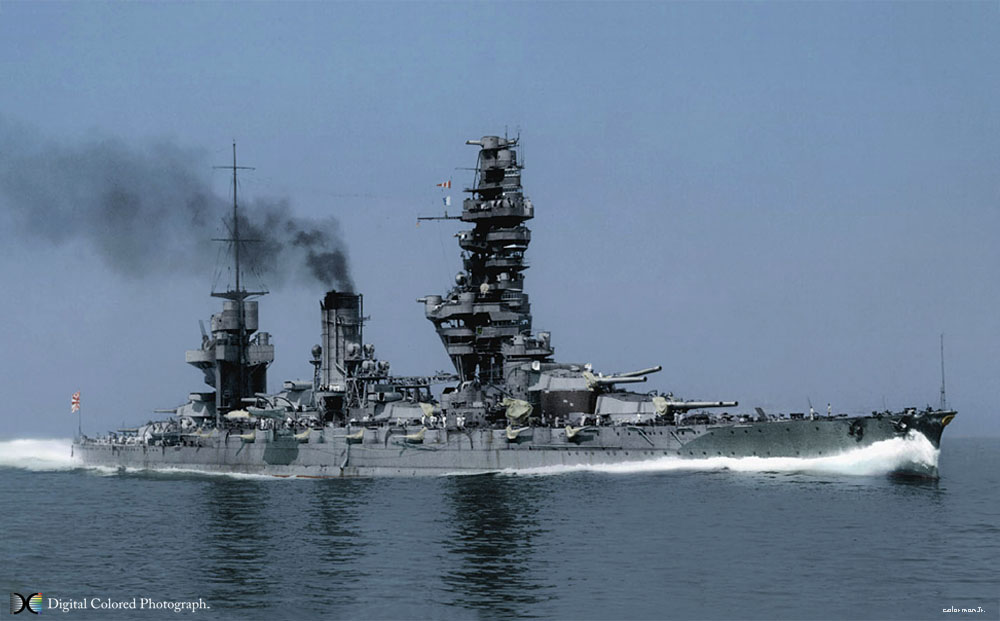 IJN Fuso colorized by Hirootoko JR
IJN Fuso colorized by Hirootoko JR
Her fate was sealed in the greatest air-naval battle of all time. In Leyte, or more exactly during the Battle of Surigao Strait on October 25, 1944, she was then under the command of Shōji Nishimura, under Rear Admiral Masami Ban, as part of Nishimura’s Southern Force. She departed from Brunei and headed for the Sulu sea. The force was headed to perform a double envelopment on the US fleet in Leyte along with Vice-Admiral Takeo Kurita’s force in Leyte Gulf, but the fleet was spotted when sailing off Mindanao. She was soon attacked by the air group of USS Enterprise, Grumman TBF Avenger, and Curtiss SB2C Helldiver dive bombers.
A bomb hit the decks near the turret and destroyed the catapult and both floatplanes, another hit the deck near Turret No. 2, knocking out the first battery, and she listed 2 degrees to starboard. but survived. The day after at 01:05 she fired in error on the Mogami. It is believed that during this night at around 03:09, she was spotted and torpedo attacked by the destroyer USS Melvin, which scored a hit amidships on the starboard side. Reports are diverging on her fate: She slowed down and left formation but for some, she broke in two and the two halves sank in about 45 min, in a pool of burning fuel, at 03:50. Only ten sailors survived, rescued by IJN Asagumo. Her wreck was rediscovered in 2017, showing that contrary to popular opinion, the hull was still in one piece, with the bow broken and angled away while the entire bridge structure was missing, detached by the force of the sinking and laying nearby.

Author’s HD illustration of the Fuso in 1940 – The Fuso in 1942 had the characteristic and impressive “pagoda”, probably the most extreme bridge superstructure ever built for a ship. It looks flimsy but was quite strong due to the tripod mast underneath. If speed was really an issue, that was quite a source of drag.
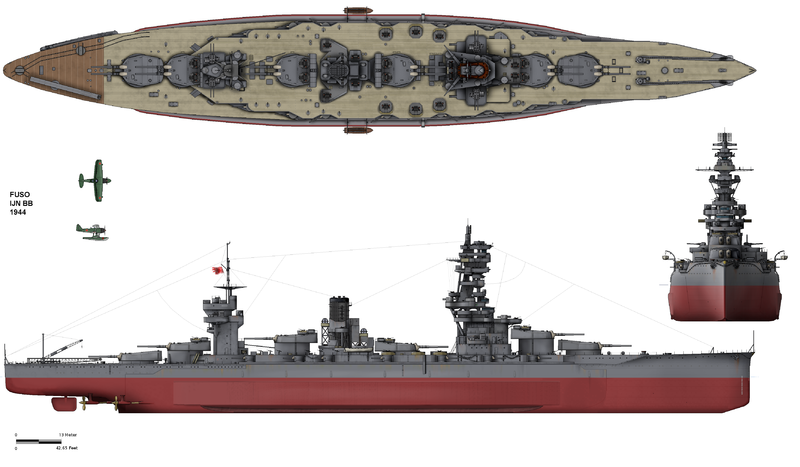
Fuso in 1944. The anti-aircraft artillery had reached its maximum, and the ship was equipped with new electronic systems, advanced telemetry and radar (wikimedia commons).
The Yamashiro in action
Her name was derived from a former province of Kyoto. She emerged from Yokosuka and was completed on the 31st of March 1917. She joined the 1st fleet, 1st division, and patrolled the coast of China until the end of WW1. Yamashiro tested an aircraft flying-off platform on Turret No. 2 in 1922, launching Gloster Sparrowhawk and Sopwith Camel fighters, a first in the IJN. After a refit, a catapult and collapsible crane were added to the stern. Both ships could eventually operate three floatplanes without a hangar, Nakajima E4N2 and later E8N2 biplanes in 1938. In 1942 these were replaced by Mitsubishi F1M biplanes.
In 1923 she assisted victims of the Great Kantō earthquake and in 1925 visited Manchuria, and was drilled along the coast. She was taken in 1930 for a large refit and emerged on 30 March 1935 under the command of Captain Chuichi Nagumo. But two years later she was back for another refit at Kure, from 27 June 1937 to 31 March 1938, and returned to service under Captain Kakuji Kakuta and later Chozaemon Obata in May 1941 under the 2nd division, 1st fleet with her sister ship (The two Fuso and two Ise class battleships constituted the 2nd division then). After heading from the Hashirajima to the Bonin Islands she served as distant support for the Pearl Harbor operation.
She was later part of the Aleutian Support Group and Operation MI (Midway), under Vice-Admiral Shirō Takasu. By 1943 she was back to serve in Japan as a training ship. There were thoughts of conversion as a hybrid ship but she was eventually fitted with a radar and additional 25 mm AA guns instead. She carried troops for Truk, but while returning to Japan took a torpedo fired by USS Halibut on IJN Junyo, though she didn’t sustain much damage. During the campaign of Saipan in June 1944 it was planned to beach her on place after carrying reinforcement troops and used her as a fixed battery. However, operation Y-GO was cancelled after the decisive defeat of the Philippine Sea.
IJN Yamashiro took part in some protective actions but without really fighting, and met her destiny at Leyte, at the battle of Surigao Strait. She was then part of Nishimura’s Southern Force and was heading to the Sulu sea when her task force was attacked by USS Enterprise’s air group. She suffered a near-miss and almost listed to 15°, while losing personnel to strafing and rocket attacks, but had no severe damage. Between 03:00 and 03:40 she was hit three times by torpedo attacks led by destroyers such as USS Monssen and Killen (of the Fletcher class).
As a result, she fell off formation and around 03:52, was spotted and was literally executed by heavy fire coming from the whole formation of Admiral Oldendorf’s squadron. She was hit by a deluge of shells from Louisville, Portland, Minneapolis, Denver, Columbia, Phoenix, Boise and battleships West Virginia, Tennessee, California, Maryland, Mississippi, and even the Australian heavy cruiser HMAS Shropshire. This lasted for 18 minutes, during which the crew fought on despite immense damage and the loss of all main turrets but four. By 04:09, she somehow worked her speed to 12 knots and later 15, trying to escape the trap. But she was later caught and took four torpedo hits from USS Bennion. She disappeared at about 04:21 and 10 crew members survived. She was rediscovered in 2017 by R/V Petrel, upside down and mostly intact, the bow folded, and internal compartments collapsed.
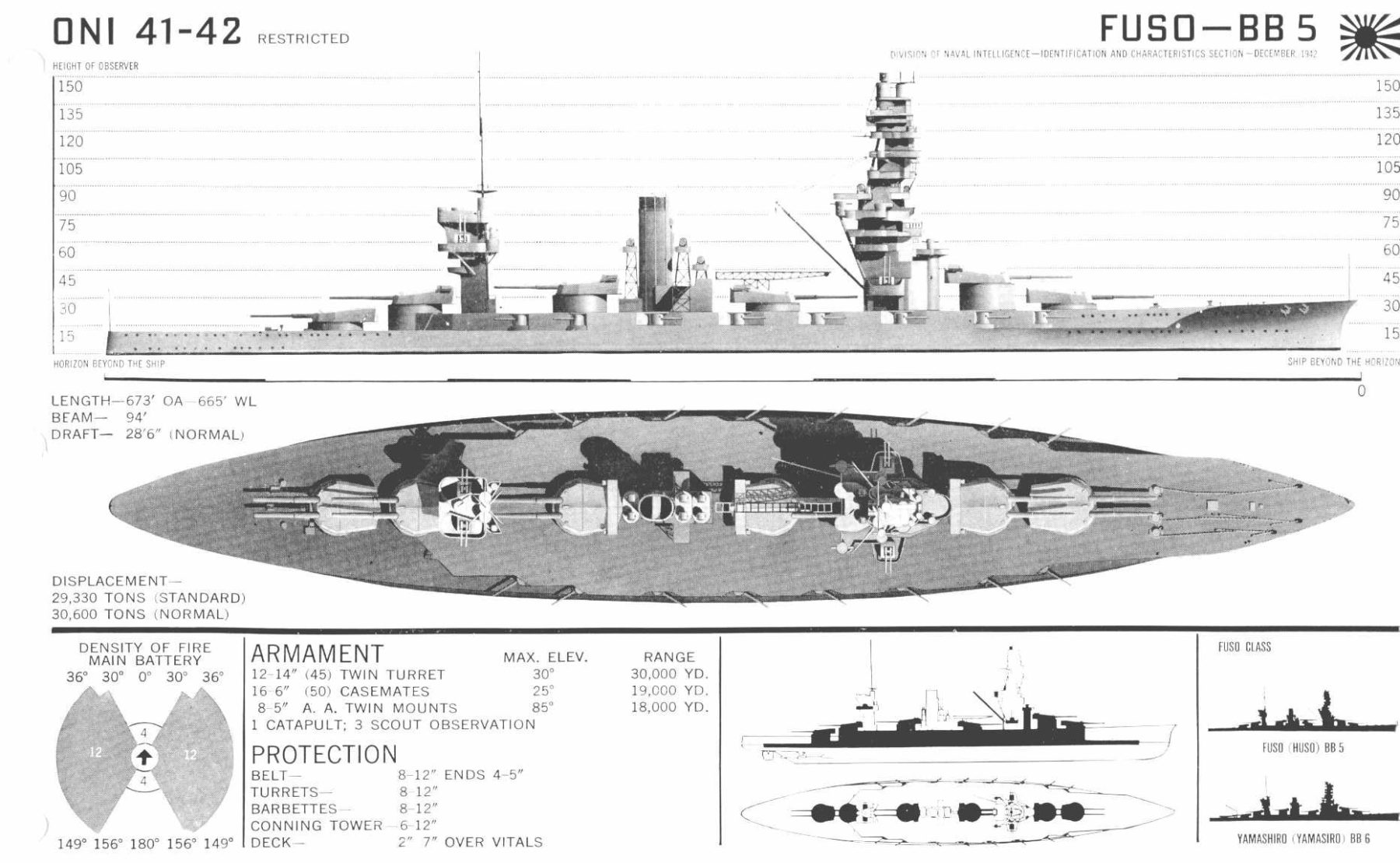
ONI silhouette recognition plates for US Navy commanders showing the Fuso with an more excessive bridge.
Specifications (1944)
Displacement: 37,500 t. standard -39 700 t. Full Load
Dimensions: 213 m long, 33.1 m wide, 9.7 m draft (full load)
Propulsion: 4 propellers, 4 Brown Curtis turbines, 8 boilers, 75,000 hp, Maximum Speed: 25 knots -RA 15,000 km/23 knots
Armor: Belt 305 mm, turrets 305 mm, barbettes 204 mm, citadel 351 mm.
Armament: 12 x 356 mm (15-in) (6×2), 14 x 152 mm (6-in) barbettes, 8 x 127 mm DP (5-in), 95 x 25 mm Type 96 AA), 3 Nakajima seaplanes.
Crew: 1550

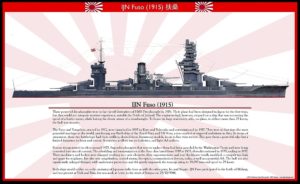
 Latest Facebook Entry -
Latest Facebook Entry -  X(Tweeter) Naval Encyclopedia's deck archive
X(Tweeter) Naval Encyclopedia's deck archive Instagram (@navalencyc)
Instagram (@navalencyc)





 French Navy
French Navy Royal Navy
Royal Navy Russian Navy
Russian Navy Armada Espanola
Armada Espanola Austrian Navy
Austrian Navy K.u.K. Kriegsmarine
K.u.K. Kriegsmarine Dansk Marine
Dansk Marine Nautiko Hellenon
Nautiko Hellenon Koninklije Marine 1870
Koninklije Marine 1870 Marinha do Brasil
Marinha do Brasil Osmanlı Donanması
Osmanlı Donanması Marina Do Peru
Marina Do Peru Marinha do Portugal
Marinha do Portugal Regia Marina 1870
Regia Marina 1870 Nihhon Kaigun 1870
Nihhon Kaigun 1870 Preußische Marine 1870
Preußische Marine 1870 Russkiy Flot 1870
Russkiy Flot 1870 Svenska marinen
Svenska marinen Søværnet
Søværnet Union Navy
Union Navy Confederate Navy
Confederate Navy Armada de Argentina
Armada de Argentina Imperial Chinese Navy
Imperial Chinese Navy Marinha do Portugal
Marinha do Portugal Mexico
Mexico Kaiserliche Marine
Kaiserliche Marine 1898 US Navy
1898 US Navy Sovietskiy Flot
Sovietskiy Flot Royal Canadian Navy
Royal Canadian Navy Royal Australian Navy
Royal Australian Navy RNZN Fleet
RNZN Fleet Chinese Navy 1937
Chinese Navy 1937 Kriegsmarine
Kriegsmarine Chilean Navy
Chilean Navy Danish Navy
Danish Navy Finnish Navy
Finnish Navy Hellenic Navy
Hellenic Navy Polish Navy
Polish Navy Romanian Navy
Romanian Navy Turkish Navy
Turkish Navy Royal Yugoslav Navy
Royal Yugoslav Navy Royal Thai Navy
Royal Thai Navy Minor Navies
Minor Navies Albania
Albania Austria
Austria Belgium
Belgium Columbia
Columbia Costa Rica
Costa Rica Cuba
Cuba Czechoslovakia
Czechoslovakia Dominican Republic
Dominican Republic Haiti
Haiti Hungary
Hungary Honduras
Honduras Estonia
Estonia Iceland
Iceland Eire
Eire Equador
Equador Iran
Iran Iraq
Iraq Latvia
Latvia Liberia
Liberia Lithuania
Lithuania Mandchukuo
Mandchukuo Morocco
Morocco Nicaragua
Nicaragua Persia
Persia San Salvador
San Salvador Sarawak
Sarawak Uruguay
Uruguay Venezuela
Venezuela Zanzibar
Zanzibar Warsaw Pact Navies
Warsaw Pact Navies Bulgaria
Bulgaria Hungary
Hungary

 Bundesmarine
Bundesmarine Dutch Navy
Dutch Navy Hellenic Navy
Hellenic Navy Marina Militare
Marina Militare Yugoslav Navy
Yugoslav Navy Chinese Navy
Chinese Navy Indian Navy
Indian Navy Indonesian Navy
Indonesian Navy JMSDF
JMSDF North Korean Navy
North Korean Navy Pakistani Navy
Pakistani Navy Philippines Navy
Philippines Navy ROKN
ROKN Rep. of Singapore Navy
Rep. of Singapore Navy Taiwanese Navy
Taiwanese Navy IDF Navy
IDF Navy Saudi Navy
Saudi Navy Royal New Zealand Navy
Royal New Zealand Navy Egyptian Navy
Egyptian Navy South African Navy
South African Navy






























 Ukrainian Navy
Ukrainian Navy dbodesign
dbodesign
You guys should probably proofread more. Also the Petrel is not an M/V she is a R/V a Research Vessel
Fixed ! Thx. Indeed, some article needs proofreading and it’s a solo blog (no guest blogging for the moment), that’s why i’m down now to one post weekly this year.
Cheers,
I wonder how it,s like being on a warship called the iv fuso i think made in brizil.Made in jupan.